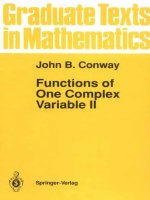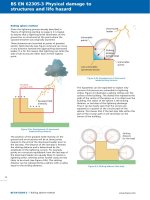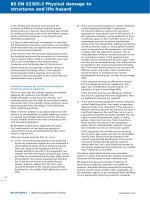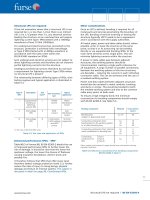Bsi bs en 00573 2 1995 (1998)
Bạn đang xem bản rút gọn của tài liệu. Xem và tải ngay bản đầy đủ của tài liệu tại đây (300.47 KB, 12 trang )
Licensed Copy: Institute Of Technology Tallaght, Institute of Technology, Wed Sep 27 23:43:57 BST 2006, Uncontrolled Copy, (c) BSI
BRITISH STANDARD
Aluminium and
aluminium alloys —
Chemical composition
and form of wrought
products —
Part 2: Chemical symbol based
designation system
The European Standard EN 573-2:1994 has the status of a
British Standard
UDC 669.71:669.715.018.26:62-777
BS EN
573-2:1995
Licensed Copy: Institute Of Technology Tallaght, Institute of Technology, Wed Sep 27 23:43:57 BST 2006, Uncontrolled Copy, (c) BSI
BS EN 573-2:1995
Cooperating organizations
The European Committee for Standardization (CEN), under whose supervision
this European Standard was prepared, comprises the national standards
organizations of the following countries:
This British Standard, having
been prepared under the
direction of the Engineering
Sector Board (E/-), was
published under the authority
of the Standards Board and
comes into effect on
15 January 1995
© BSI 12-1998
The following BSI references
relate to the work on this
standard:
Committee reference NFE/35/5
Draft for comment 91/47492 DC
ISBN 0 580 22763 4
Austria
Oesterreichisches Normungsinstitut
Belgium
Institut belge de normalisation
Denmark
Dansk Standard
Finland
Suomen Standardisoimisliito, r.y.
France
Association franỗaise de normalisation
Germany
Deutsches Institut fỹr Normung e.V.
Greece
Hellenic Organization for Standardization
Iceland
Technological Institute of Iceland
Ireland
National Standards Authority of Ireland
Italy
Ente Nazionale Italiano di Unificazione
Luxembourg
Inspection du Travail et des Mines
Netherlands
Nederlands Normalisatie-instituut
Norway
Norges Standardiseringsforbund
Portugal
Instituto Portugs da Qualidade
Spain
Asociación Espola de Normalización y Certificación
Sweden
Standardiseringskommissionen i Sverige
Switzerland
Association suisse de normalisation
United Kingdom
British Standards Institution
Amendments issued since publication
Amd. No.
Date
Comments
BS EN 573-2:1995
Licensed Copy: Institute Of Technology Tallaght, Institute of Technology, Wed Sep 27 23:43:57 BST 2006, Uncontrolled Copy, (c) BSI
Contents
© BSI 12-1998
Cooperating organizations
National foreword
Page
Inside front cover
ii
Foreword
Text of EN 573-2
National annex NA (informative) Committees responsible
National annex NB (informative) Cross-references
2
3
Inside back cover
Inside back cover
i
BS EN 573-2:1995
Licensed Copy: Institute Of Technology Tallaght, Institute of Technology, Wed Sep 27 23:43:57 BST 2006, Uncontrolled Copy, (c) BSI
National foreword
This Part of this British Standard has been prepared by Subcommittee
NFE/35/5, Wrought aluminium and aluminium alloys and is the English
language version of EN 573-2:1994 Aluminium and aluminium alloys —
Chemical composition and form of wrought products — Part 2: Chemical symbol
based designation system, published by the European Committee for
Standardization (CEN).
A British Standard does not purport to include all the necessary provisions of a
contract. Users of British Standards are responsible for their correct application.
Compliance with a British Standard does not of itself confer immunity
from legal obligations.
Summary of pages
This document comprises a front cover, an inside front cover, pages i and ii,
the EN title page, pages 2 to 6, an inside back cover and a back cover.
This standard has been updated (see copyright date) and may have had
amendments incorporated. This will be indicated in the amendment table on
the inside front cover.
ii
© BSI 12-1998
Licensed Copy: Institute Of Technology Tallaght, Institute of Technology, Wed Sep 27 23:43:57 BST 2006, Uncontrolled Copy, (c) BSI
EUROPEAN STANDARD
EN 573-2
NORME EUROPÉENNE
EUROPÄISCHE NORM
August 1994
UDC 669.71:669.715.018.26:62-777
Descriptors: Aluminium, aluminium alloys, rolled products, aluminium products, chemical composition, shape, designation, chemical
formulae, codification
English version
Aluminium and aluminium alloys — Chemical composition
and form of wrought products — Part 2: Chemical symbol
based designation system
Aluminium et alliages d’aluminium —
Composition chimique et form des produits
corroyés — Partie 2: Système de désignation
fondé sur les symboles chimiques
Aluminium und Aluminiumlegierungen —
Chemische Zusammensetzung und Form von
Halbzeug — Teil 2: Bezeichnungssytem mit
chemischen Symbolen
www.bzfxw.com
This European Standard was approved by CEN on 1994-08-17. CEN members
are bound to comply with the CEN/CENELEC Internal Regulations which
stipulate the conditions for giving this European Standard the status of a
national standard without any alteration.
Up-to-date lists and bibliographical references concerning such national
standards may be obtained on application to the Central Secretariat or to any
CEN member.
This European Standard exists in three official versions (English, French,
German). A version in any other language made by translation under the
responsibility of a CEN member into its own language and notified to the
Central Secretariat has the same status as the official versions.
CEN members are the national standards bodies of Austria, Belgium,
Denmark, Finland, France, Germany, Greece, Iceland, Ireland, Italy,
Luxembourg, Netherlands, Norway, Portugal, Spain, Sweden, Switzerland and
United Kingdom.
CEN
European Committee for Standardization
Comité Européen de Normalisation
Europäisches Komitee für Normung
Central Secretariat: rue de Stassart 36, B-1050 Brussels
© 1994 Copyright reserved to CEN members
Ref. No. EN 573-2:1994 E
Licensed Copy: Institute Of Technology Tallaght, Institute of Technology, Wed Sep 27 23:43:57 BST 2006, Uncontrolled Copy, (c) BSI
EN 573-2:1994
Foreword
This European Standard has been drawn up
by CEN/TC 132, Aluminium and aluminium alloys,
whose Secretariat is held by the Association
Franỗaise de Normalisation (AFNOR).
Within its programme of work, Technical
Committee CEN/TC 132 has been entrusted to
prepare the following standard:
EN 573-2, Aluminium and aluminium alloys —
Chemical composition and form of wrought
products — Part 2: Chemical symbol based
designation system.
This standard is part of a set of four standards. The
other standards deal with:
EN 573-1, Aluminium and aluminium alloys —
Chemical composition and form of wrought
products — Part 1: Numerical designation system.
EN 573-3, Aluminium and aluminium alloys —
Chemical composition and form of wrought
products — Part 3: Chemical composition.
EN 573-4, Aluminium and aluminium alloys —
Chemical composition and form of wrought
products — Part 4: Forms of products.
This European Standard shall be given the status of
a national standard, either by publication of an
identical text or by endorsement, at the latest
by February 1995, and conflicting national
standards shall be withdrawn at the latest
by February 1995.
In accordance with the CEN/CENELEC Internal
Regulations, the following countries are bound to
implement this European Standard: Austria,
Belgium, Denmark, Finland, France, Germany,
Greece, Iceland, Ireland, Italy, Luxembourg,
Netherlands, Norway, Portugal, Spain, Sweden,
Switzerland and United Kingdom.
2
Contents
Foreword
1
Scope
2
Normative references
3
Basis of coding
4
Rules for the coded designation of
wrought unalloyed aluminium
5
Rules for the coded designation of
wrought aluminium alloys
6
Special use of grades of wrought
aluminium and aluminium alloys
7
Alloys produced from high
purity aluminium
Annex A (normative) International
chemical symbols
Page
2
3
3
3
3
4
4
4
5
www.bzfxw.com
© BSI 12-1998
Licensed Copy: Institute Of Technology Tallaght, Institute of Technology, Wed Sep 27 23:43:57 BST 2006, Uncontrolled Copy, (c) BSI
EN 573-2:1994
1 Scope
This Part of EN 573 specifies a code of designation
applicable to aluminium and aluminium alloys as
specified in the relevant European Standards. It is
a descriptive code based primarily on chemical
symbols.
The designations in accordance with this Part
of EN 573 are intended primarily as a supplement
to the four figure designation described in EN 573-1.
This standard applies to wrought products and to
ingots intended to be wrought.
It is not applicable to:
— ingots for remelting;
— castings;
— composite products, i.e. those containing, in
addition to aluminium and its alloys, other
metallic or non-metallic materials;
— products of powder metallurgy.
2 Normative references
This European Standard incorporates by dated or
undated references, provisions from other
publications. These normative references are cited
at the appropriate places in the text and the
publications are listed hereafter. For dated
references, subsequent amendments to or revisions
of any of these publications apply to this European
Standard only when incorporated in it by
amendment or revision. For undated references the
latest edition of the publication referred to applies.
EN 573-1, Aluminium and aluminium alloys —
Chemical composition and form of wrought
products — Part 1: Numerical designation system.
EN 573-3, Aluminium and aluminium alloys —
Chemical composition and form of wrought
products — Part 3: Chemical composition.
ISO 209-1:1989, Wrought aluminium and
aluminium alloys — Chemical composition and
forms of products — Part 1: Chemical composition.
3.4 Normally all designations complying with this
coding shall be put within square brackets,
following the four figure designation.
If, exceptionally, only the chemical symbol based
designation is used, then it shall have the prefix EN,
followed by a blank, then the letter A representing
aluminium and the letter W identifying wrought
products (and ingots to be wrought).
The letter W shall be separated from the following
designation by a hyphen.
Examples:
Normal use:
EN AW-5052 or
EN AW-5052 [Al Mg2,5]
Exceptional use: EN AW-Al Mg2,5
3.5 The designations currently in use and the
corresponding chemical composition limits are
specified in EN 573-3.
3.6 Assignments or revisions of designations shall
be approved by Technical Committee CEN/TC 132.
3.7 In order to ensure consistency with other
national and international standards, and in
particular with ISO 209-1:1989 whose code of
designation is based on the same principles:
www.bzfxw.com
3 Basis of coding
3.1 The designations of aluminium and aluminium
alloys are based on the chemical symbols, usually
followed by numbers indicating the purity of
aluminium or nominal content of the considered
element.
— where the composition of an alloy is strictly
identical to the composition of an alloy registered
by ISO, the ISO designation shall be used;
— where the composition of an alloy does not
correspond to the composition of any alloy
in ISO 209-1:1989, CEN/TC 132 will create a new
designation for this alloy, and keep
ISO/TC 79 informed.
4 Rules for the coded designation of
wrought unalloyed aluminium
Designations for unalloyed aluminium for working
shall consist of the international chemical symbol of
the metal (Al) followed by the percentage purity
expressed to one or more decimal places, as
necessary.
Examples:
EN AW-1199 [Al 99,99]
EN AW-1070A [Al 99,7]
The symbol Al is separated by a blank space from
the percentage purity.
3.2 The chemical symbols used are those of the
international nomenclature (see annex A).
3.3 The numbers or figures indicating the purity of
aluminium, or the nominal content of the considered
element, are based on the chemical composition
limits given in EN 573-3.
© BSI 12-1998
3
Licensed Copy: Institute Of Technology Tallaght, Institute of Technology, Wed Sep 27 23:43:57 BST 2006, Uncontrolled Copy, (c) BSI
EN 573-2:1994
If an element is added to unalloyed aluminium at a
low content, the symbol corresponding to this
element shall be added without a space after the
percentage purity.
Example:
EN AW-1100 [Al 99,0Cu]
5.2.3 The secondary alloying elements are
distinguished by the nominal content (middle of the
range) rounded to the nearest integer of, if
necessary, to the nearest 5/10, or, for contents less
than 1 %, to the nearest 1/10.
Examples:
5 Rules for the coded designation of
wrought aluminium alloys
5.1 Basic principles
5.1.1 An alloy is designated by Al, followed by the
symbols of the main alloying element or elements.
These symbols are usually followed by numbers
which express the mass percent contents of the
considered elements, in compliance with the rules
shown in 5.2.
The symbol Al is separated by a blank space from
the remainder of the designation.
5.1.2 Where several alloying elements are deemed
to be required in the designation, they are arranged
in order of decreasing nominal contents.
EN AW-3103 [Al Mn1]
EN AW-3005 [Al Mn1Mg0,5]
EN AW-3004 [Al Mn1Mg1]
5.2.4 If the above provisions are not sufficient for
differentiating between several alloys, a suffix shall
be used: (A), (B), (C), etc.., according to the date of
submission to CEN; the first alloy submitted has no
suffix. This suffix shall be placed in parentheses to
avoid confusion with the chemical symbols.
Examples:
EN AW-2014 [Al Cu4SiMg]
EN AW-2014A [Al Cu4SiMg(A)]
6 Special use of grades of wrought
aluminium and aluminium alloys
5.1.3 If these contents are equal, the alloying
elements are arranged in alphabetical order of the
symbols.
This practice shall be restricted as far as possible. It
shall be limited to the case where the considered
application requires specific chemical composition
limits for at least one element.
A letter introducing the chemical composition can
then be used. The letter E has been allocated to
electrical applications.
Example:
Examples:
Examples:
EN AW-6061 [Al Mg1SiCu]
EN AW-2014 [Al Cu4SiMg]
EN AW-2011 [Al Cu6BiPb]
www.bzfxw.com
5.1.4 The chemical symbols for alloying elements
shall be restricted to four elements.
Example:
EN AW-7050 [Al Zn6CuMgZr]
5.2 Rules for distinguishing between two
alloys of similar compositions
5.2.1 Care shall be taken to use the simplest
possible designation.
In the case of alloys with similar compositions,
additional designations shall be used for
distinguishing between alloys. They are given, in
decreasing priority, in 5.2.2 to 5.2.4.
5.2.2 The primary alloying element shall be
distinguished by the nominal content (middle of the
range) rounded to the nearest integer or, if
necessary, to the nearest 5/10, or for contents less
than 1 %, to the nearest 1/10.
Examples:
4
EN AW-1350 [EAl 99,5] electrical
applications
EN AW-6101 [EAl MgSi] electrical
applications
EN AW-1050A [Al 99,5] general
applications
7 Alloys produced from high purity
aluminium
In certain alloys, the base metal is of high purity, for
example Al 99,85 %. It is then necessary to give the
specified high content in full. This content is given
to two decimal places; the alloying elements are
then given as set out above.
Example:
EN AW-5305 [Al 99,85Mg1]
EN AW-5251 [Al Mg2]
EN AW-5052 [Al Mg2,5]
EN AW-6063 [Al Mg0,7Si]
© BSI 12-1998
Licensed Copy: Institute Of Technology Tallaght, Institute of Technology, Wed Sep 27 23:43:57 BST 2006, Uncontrolled Copy, (c) BSI
EN 573-2:1994
Annex A (normative)
International chemical symbols
The International chemical symbols are as follows:
Aluminium
: Al
Magnesium
: Mg
Antimony
: Sb
Manganese
: Mn
Beryllium
: Be
Molybdenum
: Mo
Bismuth
: Bi
Nickel
: Ni
Boron
:B
Niobium
: Nb
Cadmium
: Cd
Rare Earths
: RE
Cerium
: Ce
Silicon
: Si
Chromium
: Cr
Silver
: Ag
Cobalt
: Co
Strontium
: Sr
Copper
: Cu
Tin
: Sn
Gallium
: Ga
Titanium
: Ti
Iron
: Fe
Vanadium
:V
Lead
: Pb
Zinc
: Zn
Lithium
: Li
Zirconium
: Zr
www.bzfxw.com
© BSI 12-1998
5
Licensed Copy: Institute Of Technology Tallaght, Institute of Technology, Wed Sep 27 23:43:57 BST 2006, Uncontrolled Copy, (c) BSI
www.bzfxw.com
6
blank
Licensed Copy: Institute Of Technology Tallaght, Institute of Technology, Wed Sep 27 23:43:57 BST 2006, Uncontrolled Copy, (c) BSI
BS EN 573-2:1995
National annex NA (informative)
Committees responsible
The United Kingdom participation in the preparation of this European Standard was entrusted by
Technical Committee NFE/35, Light metals and their alloys, to Subcommittee NFE/35/5, Wrought
aluminium and aluminium alloys upon which the following bodies were represented:
Aluminium Federation
Aluminium Stockholders’ Association
London Metal Exchange
Magnesium Industry Council
The following bodies were also represented in the drafting of the standard, through subcommittees and
panels:
Association of British Welded Aluminium Tube Makers
Association of Light Alloy Refiners Limited
Institution of Structural Engineers
Metal Packaging Manufacturers’ Association
National annex NB (informative)
Committees responsible
Publication referred to
Corresponding British Standard
EN 573-1:1994
EN 573-3:1994
BS EN 573 Aluminium and aluminium alloys — Chemical composition and
form of wrought products
Part 1:1995 Numerical designation system
Part 3:1995 Chemical composition
© BSI 12-1998
Licensed Copy: Institute Of Technology Tallaght, Institute of Technology, Wed Sep 27 23:43:57 BST 2006, Uncontrolled Copy, (c) BSI
BSI
389 Chiswick High Road
London
W4 4AL
|
|
|
|
|
|
|
|
|
|
|
|
|
|
|
|
|
|
|
|
|
|
|
|
|
|
|
|
|
|
|
|
|
|
|
|
|
|
|
|
|
|
|
|
|
|
|
|
|
|
|
|
|
|
|
|
|
|
|
|
|
|
|
|
|
|
|
|
|
|
|
|
|
|
|
|
|
|
|
|
|
|
|
|
|
|
|
|
|
|
|
|
|
|
|
|
|
|
|
|
|
|
|
|
|
|
|
|
|
|
|
|
|
|
|
|
|
|
|
|
|
|
|
|
|
|
|
BSI Ð British Standards Institution
BSI is the independent national body responsible for preparing British Standards. It
presents the UK view on standards in Europe and at the international level. It is
incorporated by Royal Charter.
Revisions
British Standards are updated by amendment or revision. Users of British Standards
should make sure that they possess the latest amendments or editions.
It is the constant aim of BSI to improve the quality of our products and services. We
would be grateful if anyone finding an inaccuracy or ambiguity while using this
British Standard would inform the Secretary of the technical committee responsible,
the identity of which can be found on the inside front cover. Tel: 020 8996 9000.
Fax: 020 8996 7400.
BSI offers members an individual updating service called PLUS which ensures that
subscribers automatically receive the latest editions of standards.
Buying standards
Orders for all BSI, international and foreign standards publications should be
addressed to Customer Services. Tel: 020 8996 9001. Fax: 020 8996 7001.
In response to orders for international standards, it is BSI policy to supply the BSI
implementation of those that have been published as British Standards, unless
otherwise requested.
Information on standards
BSI provides a wide range of information on national, European and international
standards through its Library and its Technical Help to Exporters Service. Various
BSI electronic information services are also available which give details on all its
products and services. Contact the Information Centre. Tel: 020 8996 7111.
Fax: 020 8996 7048.
Subscribing members of BSI are kept up to date with standards developments and
receive substantial discounts on the purchase price of standards. For details of
these and other benefits contact Membership Administration. Tel: 020 8996 7002.
Fax: 020 8996 7001.
Copyright
Copyright subsists in all BSI publications. BSI also holds the copyright, in the UK, of
the publications of the international standardization bodies. Except as permitted
under the Copyright, Designs and Patents Act 1988 no extract may be reproduced,
stored in a retrieval system or transmitted in any form or by any means ± electronic,
photocopying, recording or otherwise ± without prior written permission from BSI.
This does not preclude the free use, in the course of implementing the standard, of
necessary details such as symbols, and size, type or grade designations. If these
details are to be used for any other purpose than implementation then the prior
written permission of BSI must be obtained.
If permission is granted, the terms may include royalty payments or a licensing
agreement. Details and advice can be obtained from the Copyright Manager.
Tel: 020 8996 7070.









